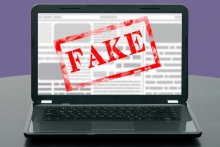Detecting Fake News
Date Posted:
February 7, 2019
Date Recorded:
November 1, 2018
CBMM Speaker(s):
Xavier Boix Speaker(s):
Sofia Latessa
All Captioned Videos CBMM Research VIDEO
Description:
New work from MIT researchers peers under the hood of an automated fake-news detection system, revealing how machine-learning models catch subtle but consistent differences in the language of factual and false stories. The research also underscores how fake-news detectors should undergo more rigorous testing to be effective for real-world applications.
[MUSIC PLAYING] XAVIER BOIX: My name is Xavier Boix. I work at the Center for Brains, Minds, and Machines. In the lab, we develop technologies for machine learning and AI. And these technologies have an impact on society, and they can be used for good or bad. We feel that we need to take responsibility on this, and this project is also a way to show students how these technologies can be used for social good.
Nicole O'Brien was a grad student in the lab. She did the master thesis with us on fake news detection. After Nicole graduated, Sophia Latessa refined the result on the courses.
SOPHIA LATESSA: The main goal of the project was to see if the machine could detect real news to fake news, regardless of source and author.
XAVIER BOIX: So first of all, we collected a data set of real and fake news.
SOPHIA LATESSA: So this data set had examples of articles that were factually correct and factually incorrect. Our next step is to train our machine.
XAVIER BOIX: And what we did in this case, in order to make it even more challenging, we removed from the training all articles related to Donald Trump.
SOPHIA LATESSA: So we fed that training set to the machine. We are saying this one is fake. Figure out why it's fake. This one is real. Figure out why it's real. And from that point, we tested our machine.
XAVIER BOIX: So the machine has never seen an article that speaks about Donald Trump. And at testing, we only test with articles of Donald Trump. We thought it would be maybe interesting results to check.
DONALD TRUMP: A lot of what you read and a lot of what you see on television is fake. They realize it. The people are smart.
SOPHIA LATESSA: After he ran our analysis, we noticed that there is a subtle difference between the fake news articles and the real news articles. Within the fake news articles, it's shown that there are many hyperbolas and superlatives. And within the real news articles, there is a tone that's a little bit more conservative, and the verbs are more carefully chosen.
XAVIER BOIX: Yeah, we wanted to see if this could be useful for not only an experiment in a lab.
SOPHIA LATESSA: So it's really exciting. We created a visualization component. So you can actually insert a body of text, and it'll show you how the neural network is analyzing the article. And it'll say this phrase is more fake, and this other phrase is more real.
Right now, fake news is extremely problematic. We've seen that it impacts society. We've seen that it impacts us politically. And overall, having misinformation spread online can have a huge societal impact.
XAVIER BOIX: I think with the technologies we are developing in the lab, we can do something about it. So that's why we did this project, yeah.
[MUSIC PLAYING]

 have an interactive transcript feature enabled, which appears below the video when playing. Viewers can search for keywords in the video or click on any word in the transcript to jump to that point in the video. When searching, a dark bar with white vertical lines appears below the video frame. Each white line is an occurrence of the searched term and can be clicked on to jump to that spot in the video.
have an interactive transcript feature enabled, which appears below the video when playing. Viewers can search for keywords in the video or click on any word in the transcript to jump to that point in the video. When searching, a dark bar with white vertical lines appears below the video frame. Each white line is an occurrence of the searched term and can be clicked on to jump to that spot in the video.
